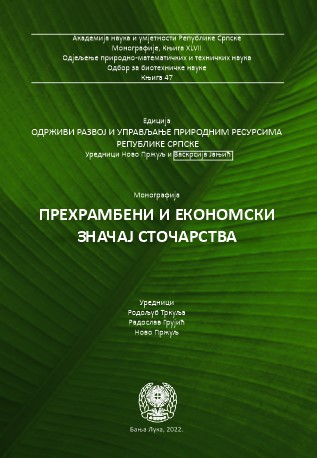Cattle production
DOI:
https://doi.org/10.7251/EORU2204001KKeywords:
Livestock production, cattle production, milk, meat, quality and product safetyAbstract
In agriculture, livestock is a priority for several reasons. Significant arable land for the production of field crops, feedstuff plants and artificial meadows are in the function of animal feed production. The value of field production is enriched through transfer to high-value animal products. In addition to basic products, farmed animals also provide a number of by-products that increase the overall economic value of livestock. The population engaged in agriculture earns over 60% of the total income through livestock and livestock products. The tradition of keeping and raising animals in Bosnia and Herzegovina (B&H) and RS is long, and over the centuries it has ensured the existence of the population, especially in the hills and mountainous areas. Significant parts of B&H are rich in vast pastures, which were the main source of animal feedstuffs, and observed through modern projections, could become experimental and profitable areas for organic livestock, especially ruminants (cattle, sheep and goats). The primary importance of cattle production is reflected in the production of meat and milk, as top and irreplaceable sources of protein food for humans. In addition, the "cattle industry" provides raw materials for the food industry, but also through by-products that are indispensable in other industrial branches. Of special importance is the biological connection with field crop production, and vegetable and fruit production, as animal manure returns important elements such as nitrogen, phosphorus and potassium to the soil. According to the latest census, there were close to 1.3 billion cattle in the world. In certain areas of the planet, due to exceptional vegetation benefits, there is an overpopulation of cattle, which according to environmental parameters is considered to exert a negative impact on climate change and leads to the emergence of the greenhouse effect (methane and carbon monoxide emissions). Until the 1990s, the number of cattle in B&H was close to 870,000, and today, according to estimates, it is nearly 455,000. Given the importance of this production, the „Cattle Breeding Program” in the Republic of Srpska for the period 2016-2021 was adopted with the goal of significantly increase the population of cattle and to improve its genetic potential. For successful cattle production, it is necessary to develop and support the animal health care system, especially against dangerous infectious diseases and emerging and re-emerging diseases whose appearance and presence endangers animal health, often human health, but also brings great economic losses and prevents international trade opportunities. It is necessary to permanently educate the farmers on issues related to animal husbandry, hygiene and biosecurity measures on the farm, the importance of animal health and safety of animal products for human use, but also on all other elements of good farm practice. Therefore, it is necessary to encourage the establishment of organized forms of associations of producers according to the types of production, with the aim of more efficiently resolving common issues.
